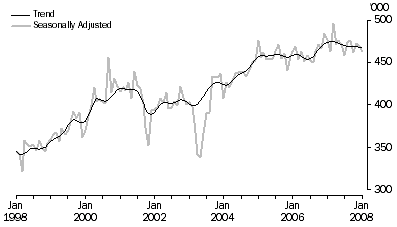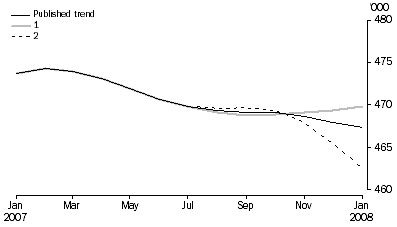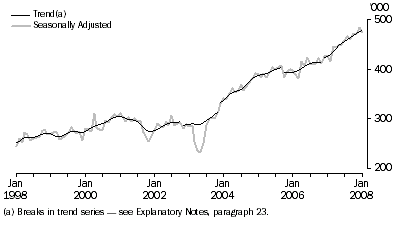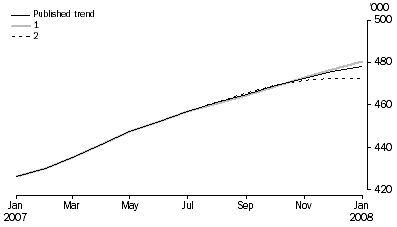MAIN FEATURES
SHORT-TERM VISITOR ARRIVALS
In trend terms, short-term visitor arrivals to Australia during January 2008 (467,400 movements) changed little compared with December 2007 (467,900 movements). Currently, short-term visitor arrivals are 1.3% lower than in January 2007.
SHORT-TERM VISITOR ARRIVALS, Australia

The following table presents the top ten source countries (based on original estimates) for short-term visitor arrivals during January 2008. When trend estimates for short-term visitor arrivals for January 2008 and January 2007 were compared the highest percentage gain was recorded by China (16.4%) while the highest percentage loss was recorded by Korea (17.6%).
Short-term Visitor Arrivals, Australia(a) - January 2008 |
|  |
 | Trend | Seasonally Adjusted | Original | Dec 07 to Jan 08 | Jan 07 to Jan 08 |  |
 | '000 | '000 | '000 | Trend % change | Trend % change |  |
|  |
| New Zealand | 93.9 | 92.2 | 66.7 | 0.2 | 0.1 |  |
| United Kingdom | 55.1 | 54.9 | 65.0 | -0.7 | -10.8 |  |
| Japan | 42.4 | 39.1 | 39.2 | -2.9 | -16.8 |  |
| United States of America | 38.8 | 38.2 | 37.1 | -0.3 | 1.7 |  |
| China | 32.1 | 33.3 | 35.5 | 1.1 | 16.4 |  |
| Korea | 18.8 | 19.2 | 27.9 | -1.8 | -17.6 |  |
| Germany | 12.9 | 13.1 | 13.8 | 1.1 | 2.8 |  |
| Canada | 9.7 | 9.7 | 13.0 | -0.4 | 6.3 |  |
| Singapore | 22.0 | 22.1 | 12.9 | -0.1 | -0.7 |  |
| Hong Kong | 12.7 | 13.2 | 9.8 | 1.0 | 0.2 |  |
|  |
| (a) Top ten source countries based on original estimates. |
'What if'....? Future scenarios
The most recent trend estimates for short-term visitor arrivals are likely to be revised when the next month's seasonally adjusted estimates become available. To assist in analysing these movement trends, the approximate effects of two possible scenarios on the previous trend estimate of short-term visitor arrivals is presented:
1 The February seasonally adjusted estimate of visitor arrivals is 2.8% higher than January.
2 The February seasonally adjusted estimate of visitor arrivals is 2.8% lower than January.
WHAT IF...? REVISIONS TO SHORT-TERM VISITOR ARRIVALS, Trend Estimates

The figure of 2.8% for visitor arrivals represents the average absolute monthly percentage change for visitor arrivals over the last ten years. For further information on the effect of new seasonally adjusted estimates on short-term visitor arrival trend estimates see paragraph 25 of the Explanatory Notes.
SHORT-TERM RESIDENT DEPARTURES
In trend terms in January 2008, short-term resident departures (478,000 movements) increased by 0.5% compared with December 2007 (475,800 movements). Short-term resident departures are currently 12.1% higher than in January 2007.
SHORT-TERM RESIDENT DEPARTURES, Australia

The following table presents the top ten destinations (based on original estimates) for short-term resident departures during January 2008. When trend estimates for short-term resident departures for January 2008 and January 2007 were compared percentage gains were recorded by all top ten countries. The highest percentage gain was recorded by Indonesia (35.3%). This followed two breaks in the time series after the Bali bombing in October 2005 and indicates that Australian residents are returning to Bali for holidays (see the graph for Indonesia in Appendix 2, Seasonally Adjusted and Trend Estimates).
Short-term Resident Departures, Australia(a) - January 2008 |
|  |
 | Trend | Seasonally Adjusted | Original | Dec 07 to Jan 08 | Jan 07 to Jan 08 |  |
 | '000 | '000 | '000 | Trend % change | Trend % change |  |
|  |
| New Zealand | 76.1 | 75.9 | 77.0 | -0.2 | 3.4 |  |
| United States of America | 41.6 | 40.6 | 36.5 | -0.4 | 11.2 |  |
| Thailand | 31.6 | 32.7 | 30.8 | 0.5 | 10.9 |  |
| Indonesia | 30.4 | 30.9 | 26.7 | 5.9 | 35.3 |  |
| China | 24.5 | 24.8 | 21.6 | 0.3 | 12.9 |  |
| United Kingdom | 36.5 | 35.0 | 19.3 | -0.1 | 9.3 |  |
| Fiji | 19.3 | 19.4 | 18.2 | 2.0 | 31.8 |  |
| Japan | 13.5 | 13.6 | 17.8 | 4.5 | 30.9 |  |
| Viet Nam | 13.0 | 13.2 | 17.8 | -1.1 | 7.5 |  |
| Singapore | 18.5 | 17.3 | 16.2 | -1.5 | 8.8 |  |
|  |
| (a) Top ten destination countries based on original estimates. |
'What if'....? Future scenarios
The most recent trend estimates for short-term resident departures are likely to be revised when the next month's seasonally adjusted estimates become available. To assist in analysing these movement trends, the approximate effects of two possible scenarios on the previous trend estimate of short-term resident departures is presented:
1 The February seasonally adjusted estimate of resident departures is 3.0% higher than January.
2 The February seasonally adjusted estimate of resident departures is 3.0% lower than January.
WHAT IF...? REVISIONS TO SHORT-TERM RESIDENT DEPARTURES, Trend Estimates

The figure of 3.0% for resident departures represents the average absolute monthly percentage change for resident departures over the last ten years. For further information on the effect of new seasonally adjusted estimates on short-term resident departure trend estimates see paragraph 25 of the Explanatory Notes.
PERMANENT AND LONG-TERM MOVEMENTS
Statistics on overseas arrivals and departures relate to the number of movements of travellers rather than the number of travellers. Care should be taken when using permanent and long-term movements data as it is known that some individuals who travel multiple times in a year are counted each time they cross Australia's borders (see paragraph 5 of the Explanatory Notes). Permanent and long-term movements in this publication are not an appropriate source of migration statistics. For further information refer to Australian Demographic Statistics (cat. no. 3101.0) and Information Paper: Statistical Implications of Improved Methods for Estimating Net Overseas Migration, Australia, 2007 (cat. no. 3107.0.55.005).
There were 12,960 permanent (settler) arrivals to Australia during January 2008, an increase of 10.0% compared with January 2007 (11,780 movements). People born in New Zealand accounted for the largest proportion of settlers (26%), followed by people born in the United Kingdom (16%), India (9%) and China (7%).
There were 10,500 Australian residents departing permanently from Australia during January 2008, an increase of 8.0% compared with January 2007 (9,720 movements).
STATISTICAL SIGNIFICANCE
The above presentation of movements in estimates does not take into account whether the change in movement is statistically significant. Care should be taken when interpreting the impact of numeric and/or percentage change. Please see the Standard Errors section of this issue for more detail.
 Print Page
Print Page
 Print All
Print All